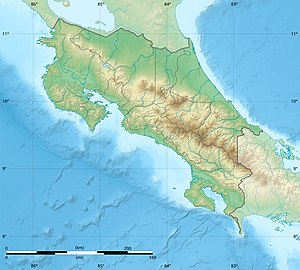| Turrialba Volcano National Park | |
|---|---|
 Turrialba Volcano | |
 Turrialba Volcano National Park area. | |
| Location | Costa Rica |
| Coordinates | 10°1′48″N83°46′12″W / 10.03000°N 83.77000°W |
| Area | ~3,900 acres (16 km²) |
| Established | 30 July 1955 |
| Governing body | National System of Conservation Areas (SINAC) |
Location in Costa Rica | |
Turrialba Volcano National Park, or in Spanish the Parque Nacional Volcan Turrialba is a national park in the Central Conservation Area of Costa Rica that encompasses the area around the Turrialba Volcano in Cartago Province.
Contents
Major eruptions in the past have occurred in the years between 1864 and 1868. Volcanism increased in the park starting in 2014 and has featured ash clouds that have repeatedly impacted portions of Costa Rica with deposits of gritty soot and caused temporary closures of Juan Santamaría International Airport in the capital city of San Jose. [1]
